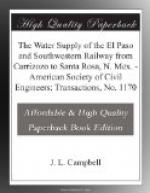At least 27 pieces of cracked pipe got past the field inspectors and into the trench. This cracked pipe began blowing out at a pressure of 50 lb., and continued until the full normal pumping pressure was reached, when the breaks suddenly ceased. These pipes were broken out at the rate of 1 or 2 per day, with an occasional day between breaks. A 24-hour work-train service was maintained. The pipe gang soon became skilled, and could put in a new section of pipe in from 4 to 6 hours. Each break generally caused an interruption of about 6 hours to the pumps on the section where it occurred. The best record was 3 hours and 50 min. from the stopping to the starting of the pumps. This strenuous life lasted 30 days. Most of these breaks were in or near the middle of the pipe. Evidently, the field inspectors were not expecting cracks in that locality. An inspection usually indicated that the pipe had been struck by the bell of another one in the vicinity of the break.
All pipes were lifted from the car carefully and laid down at the trench along the track in a single movement by a logging crane, and were not broken in such handling.
Three breaks only have been reported as due to defective metal or casting. No break of a sound shell of full thickness has been found.
Trenching.—Deep frosts are unknown in this section. The pipe was laid so that the top was about 1 ft. below the surface of the ground. The trenching was a simple matter. Part of the work between Bonito and the railway on the Carrizozo plain was done by Buckeye ditchers. All other ditching was done by a railroad plow followed by pick and shovel, or by the two latter tools only. The ditcher could open 2,000 ft. of trench per day, but averaged about 500. The plow and 35 men could open 3,500 ft. A chain about 6 ft. long separated the end of the plow beam and the double tree. In this way the trench was plowed to the bottom. Two mules, two men, and a scraper could back-fill 3,500 ft. per day.
Pipe Laying.—Between Bonito and the railway, one gang of ten men could lay 4,000 ft. of 12-in. pipe per day. The average was much less, owing to a variety of causes. At the end, the railway company added to the contractor’s force, and laid the last 10 miles of pipe in 7 days, there being a half dozen separate gangs at work.
Along the railway, the day’s record on wood pipe was 4,000 ft. of 11-in., 6,200 ft. of 7-1/2-in. and 8345 ft. of 3-1/2-in, pipe laid by a gang of eight men after the pipe was distributed along the trench. These eight men, of whom five were Americans, laid 76 miles of pipe, and became expert. Their operation was like the working of a clock.
On the 12-in. iron pipe, the regular day’s work was 96 joints, or 1,152 ft. of pipe laid and caulked. The record was 1,644 ft. Two gangs laid 101,300 lin. ft. in 60 days. Such a gang consisted of 1 foreman, 1 inspector, 8 caulkers, 4 yarners, 1 melter, 1 pourer, 1 helper, and 10 men putting pipe into the trench.




